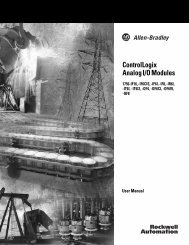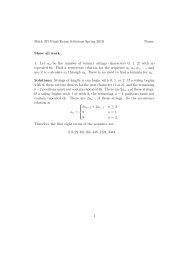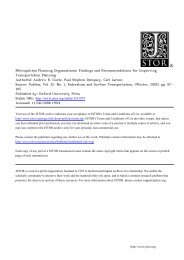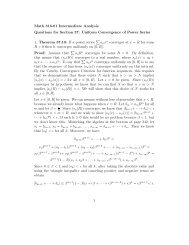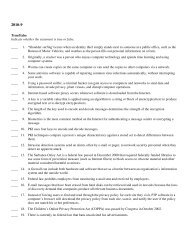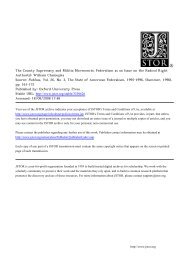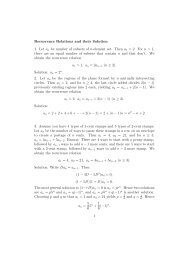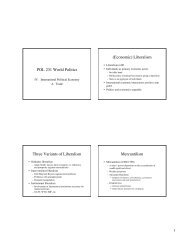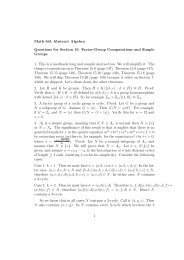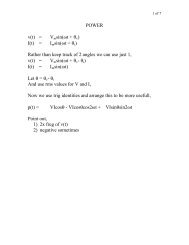Clemons and McBeth - MavDISK
Clemons and McBeth - MavDISK
Clemons and McBeth - MavDISK
You also want an ePaper? Increase the reach of your titles
YUMPU automatically turns print PDFs into web optimized ePapers that Google loves.
58<br />
Once again these categories are interrelated <strong>and</strong> influence each other. The factors discussed<br />
as falling under the intellectual/analytical umbrella also interact with these factors,<br />
<strong>and</strong> indeed both are intertwined with the ideological/philosophical factors to be discussed<br />
subsequently.<br />
Political System While there is no political system that could guarantee or deliver rationality,<br />
the political system that exists in the United States-for all its strengths-can be cited<br />
as proof of, <strong>and</strong> a contributor to, the nonrationality of the policy process <strong>and</strong> policy outcomes.'<br />
The most commonly proclaimed essential characteristics of the polity known as the<br />
United States of America are political pluralism, federalism, fragmentation, legalism, checks<br />
<strong>and</strong> balances, incrementalism, <strong>and</strong> an element of democracy. These characteristics are also the<br />
key parameters of the political system. This is not the place for a discussion of these aspects,<br />
but rather for examining the impact these characteristics have on policy.<br />
Policymaking in the United States generally requires consensus building to put majorities together.<br />
It is easier to stop policy development than to change or create it. Dramatic <strong>and</strong> radical<br />
change is rare. As Braybrooke <strong>and</strong> Lindblom explain, "NonincrementaI alternatives usually do<br />
not lie within the range of choice possible in the society or body politic." (The) "nonincrementaI<br />
(is) often politically irrelevant. . . we always begin somewhere, not ad nihilo" (pp. 73, 89, 83).<br />
Clear m<strong>and</strong>ates are extremely rare <strong>and</strong> for any given issue there are multiple stakeholders,<br />
with legitimate <strong>and</strong> conflicting claims (both individuals <strong>and</strong> groups) who can affect, <strong>and</strong> are<br />
affected by, policy decisions.<br />
As the earlier discussions of group <strong>and</strong> elite theory suggested, not all players, or policies,<br />
are created equal. Nondecisions are cornmon. Nondecisions occur when issues are taken off,<br />
or never placed onto, the table. The policy process offers many opportunities for contestants<br />
to get into the game, <strong>and</strong> it should be thought of as a never-ending, ongoing process in which<br />
the outcomes of earlier battles are relevant to, but not determinant of, today's policy outcomes.<br />
The result is a messy process where, as John Kingdon (1984/1995) suggests, policy tends<br />
to occur more than be made, <strong>and</strong> policies that can gain the necessary level of political support,<br />
not necessarily the most rational policies, are the ones that win out.<br />
Writing about the making of environmental policy, Dean Mann (1986) powerfully captured<br />
the relationship between policy <strong>and</strong> the political system of the United States that produces it.<br />
He described the pattern of policymaking as being marked by "a process of dramatic advances,<br />
incomplete movement in the 'right' direction, frequent <strong>and</strong> partial retrogression, sometimes<br />
illogical <strong>and</strong> contradictory combinations of policies, <strong>and</strong> often excessive cost. . . ." He concluded<br />
this discussion with the observation that this ". . . should come as no surprise to students of<br />
American politics" (p. 4). The political system is based on value conflict, politics, self-interest,<br />
the public interest, <strong>and</strong> coalition building; it is fragmented <strong>and</strong> tied to political culture, <strong>and</strong>,<br />
as a result, the making of policy is far from rational.<br />
While a perfect following of the rational model seems impossible, a famous example of a<br />
rather rational <strong>and</strong> comprehensive policy is the energy policy that President Jimmy Carter, a<br />
nuclear engineer <strong>and</strong> policy wonk, devised. However, his political strategy was not nearly as<br />
well developed as his policy plan. While Carter knew the details <strong>and</strong> substance of the issue, he<br />
did not underst<strong>and</strong> the need for stroking egos, striking fear in opponents, or swapping political<br />
'This discussion builds on, <strong>and</strong> makes more specific to the United States. the earlier explanation of political<br />
systems in Chapter J.<br />
PARTI . THEORY AND PRACTICE CHAPTER3 . CR/TlQUES OF THE RATIONAL ApPROACH 59<br />
favors. The Carter White House failed to generate <strong>and</strong> gamer the political support necessary for<br />
his policy. It failed to become law not because of its substance, but because of poor politics.'<br />
In another political system, the head of government might have been able to simply impose<br />
his or her policy on their society. Instead, the nature of the political system of the United States<br />
has produced an energy policy that much more closely fits the portrait painted of the making of<br />
environmental policy by Dean Mann. To the extent that the United States has an energy policy<br />
(<strong>and</strong> not having a public policy is a policy), it was created through bursts of partial progress <strong>and</strong><br />
steps backward <strong>and</strong> features legislation <strong>and</strong> goals that contradict other legislation <strong>and</strong> goals.<br />
The Nature of Organizations The ideas that we have bundled under the rubric of the<br />
nature of organizations offer little comfort to anyone wishing to believe in the rational model.<br />
As descriptions of large organizations though, they ring true to astute observers <strong>and</strong> participants.<br />
Organizations <strong>and</strong> their leaders designate authority <strong>and</strong> divide work. They train employees<br />
<strong>and</strong> establish organizational objectives. They limit access to information <strong>and</strong> st<strong>and</strong>ardize<br />
<strong>and</strong> fragment the information sought <strong>and</strong> recorded through, for example, the use of st<strong>and</strong>ardized<br />
forms. They limit the amount of time, money, <strong>and</strong> personnel available to work on any<br />
given problem. They institute rigid routines <strong>and</strong> st<strong>and</strong>ard operating procedures (SOPs). As<br />
Alex<strong>and</strong>er George <strong>and</strong> others have demonstrated, the way decision makers <strong>and</strong> organizations<br />
are organized to process information is also important (1980). Permanent, professional policy<br />
shops <strong>and</strong> temporary ad hoc committees thrown together to quickly address a crisis are<br />
quite likely to produce different advice.<br />
The effect of all this is to create agency cultures, behavioral patterns, <strong>and</strong> decisional<br />
premises that guide decision makers. So, while in one very real sense individuals decide, in<br />
another equally real sense organizations, or subunits within organizations, decide.<br />
A related idea is role theory, <strong>and</strong> the contention of Miles' Law-discussed in Chapter 1that<br />
one's stance on any given issue is determined by one's position (where you st<strong>and</strong> depends<br />
on where you sit). This may be stated too deterministically, but it is a crucial insight into decision<br />
making <strong>and</strong> the impact that the particular organization, or branch of an organization,<br />
involved in the decision can have. Units <strong>and</strong> subunits tend to view policies that are good for<br />
them <strong>and</strong> their particular clients as sacred cows, while issues that do not affect them may be<br />
ignored or marginalized. All things being equal, the top Air Force brass is undoubtedly less<br />
likely than the top Army brass to doubt the efficacy of aerial bombing. As McNamara detailed,<br />
this was indeed the case. The effect of role on policy analysis is not an easy one to deal with<br />
even for an ethical analyst. Consider briefly the following mini-case.<br />
'This paragraph draws upon Charles O. Jones's policy classic, An Introduction 10 tlte Study of Public Policy,<br />
3rd ed. (1984), pp. 107-108.<br />
D ead the following scenarios <strong>and</strong> decide what you would do as an analyst. These sceftnarios<br />
raise severalimportantissues, includingthe following:<br />
Who does the analyst really work for?<br />
Can the analyst really be a neutral party?<br />
(continued)





